*Keyboardkraze now has a nearly 24/7 chat service directly with me should you have any questions regarding keyboard/plugin choices! This is connected directly to me and it is not AI.
Table of Contents
I tested 40+ digital pianos and keyboards in the process of creating the ultimate guide for those looking to start playing or simply upgrade. I have covered every price point and done the dirty work in eliminating options that didn’t stand up to those on this list.
Keyboards are complex instruments as there’s a lot to understand prior to purchasing one. By the end of this guide, you’ll have an idea as to what to look for and what to value when choosing.
Here’s a quick review of the best keyboards/digital pianos currently available in 2024:
- Casio CT-X700 – Best portable keyboard for under $200
- Alesis Recital Pro – Best budget digital piano with weighted keys
- Korg B2 – Best digital piano under $500
- Roland fp-30X – Best intermediate digital piano under $1,000
- Casio Privia PX-S7000 – Best console digital piano near $2,500
- Roland FP-90X – Best portable digital piano under $2,500
- Kawai CA59 – Best professional digital piano under $4,000
- Roland GP-9 – Best digital piano money can buy
While I’ve created this to be the ultimate guide to meet your needs, I also offer the only independent digital piano consulting service in which I will help you choose which one to get for your specific needs.
So What’s The Best Choice If Money And Space Aren’t A Concern?
After spending a full weekend with the Roland GP series and comparing it with everything else on the market, including the Yamaha CLP series, I quickly came to the conclusion that this is currently unmatched if you have the budget. This is without a doubt the best playing and sound digital piano I've ever laid hands on, offering massive bass sound and deep brightness in the right hand.
When I first sat down at the GP-9, I honestly was shocked. I spent a solid 4-5 hours straight playing with both headphones and without. The GP-9 has something no other option I’ve ever played has and that’s the low end vibration and sonic boom it gives off when you hammer a chord. It absolutely surrounds you the way a real grand piano does.
Here’s What You Need To Know Before Purchasing A Digital Piano/Keyboard

Below are the main factors that you should consider when purchasing a digital piano.
Weighted Keys Vs Non-Weighted Keys
Nearly every instructor including myself will recommend to pianists a keyboard that has weighted keys. With this being said, weighted keys isn’t required to learn the piano.
The reason why piano instructors strongly recommend weighted keys is for finger dexterity and strength.
Acoustic piano keys are heavy and if you learn on a keyboard without weighted keys, you could develop poor technique and habits early on.
Should you or your child be looking for an experience that is closest to playing on a real acoustic piano, should go with an option with either fully-weighted keys or graded hammer action keys.
Graded hammer action keyboards are more expensive as each key is weighted differently from top to bottom like an acoustic piano.
If your child is younger, you can test the waters and check out some great keyboards for kids prior to spending more money.
Features
Certain digital pianos will come with additional features such as Bluetooth, recording abilities, and even subscriptions to certain online piano lessons.
The good news here is that you don’t have to spend a ton on a digital piano to get some great features and bundled software.
Budget
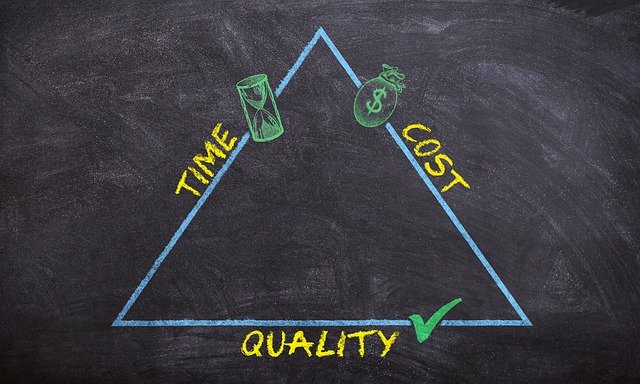
Unfortunately, like everything in life, your budget will play into the overall quality of your digital piano. As the price goes up, key features, sound quality, and overall quality tend to as well.
Intentions
If you are intending on learning to play the piano and you don’t care about have a bunch of excess songs, I recommend going with one of the cheaper digital pianos listed below.
Should you go with a keyboard, you will have more sound presets, but you will also lose some key components such as weighted keys and solid speakers.
Space
As you go up in price, you tend to get heavier, larger keyboards. While they will ultimately be smaller than acoustic pianos, you can still run into space issues depending on your living situation.
Polyphony
The polyphony becomes very important as you start to look at the higher-end of digital pianos. For beginners, I don’t believe it to be as important.
With this being said, I think it’s smart to try and go for over 64 note polyphony at the very minimum.
Should you be looking for a higher-end digital piano, then I would recommend at minimum 96 note polyphony and preferably 128 or more.
Here is a beginner’s guide to polyphony, should you be interested!
Console VS Portable Digital Pianos
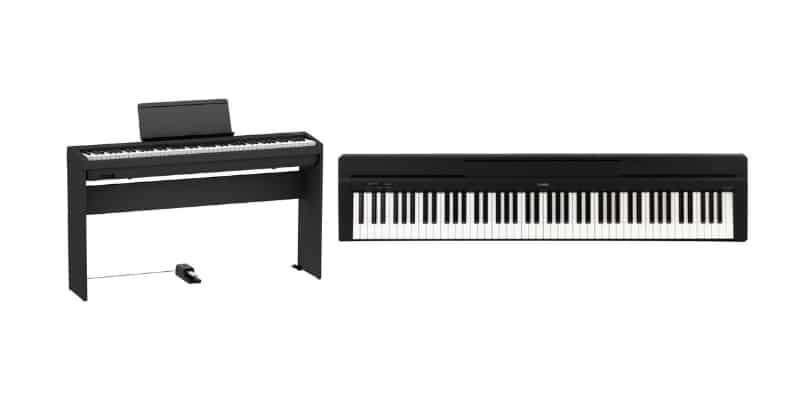
Once you get to the intermediate range of digital pianos, you will have to ask yourself if you want a console-style or portable style digital piano?
Personally, I always go with the portable style. They are far more portable and typically just as powerful.
If you’re looking for a digital piano that also doubles as a furniture piece, then console is perfect for you.
Best Keyboard Pianos Under $200
We are going to kick this list off with the cheapest keyboards we recommend. These are extremely portable options and they will not have weighted keys.
Should budget be a major factor, or if you are simply looking for a solid option for your kids, these are a great place to start.
Note: The most keys that we were able to find for this price range was 61. This is actually a solid amount of keys to begin learning on and what I began lessons on some 20 years ago.
Should you choose to want weighted keys, continue below to get to some digital pianos with weighted keys.
10) Casio CT-X700 – High Quality Presets For The Price
The Casio CT-X700 is extremely budget friendly. It is a great choice if you don't care about weighted keys and you want a lot of sounds.
The CT-X700 is easily one of the most affordable options available. This is technically an arranger keyboard, meaning you can instantly play with a backing band.
This being said, the CT-X700 has created waves since recently coming out as it offers over 600 presets that are sure to keep beginners entertained.
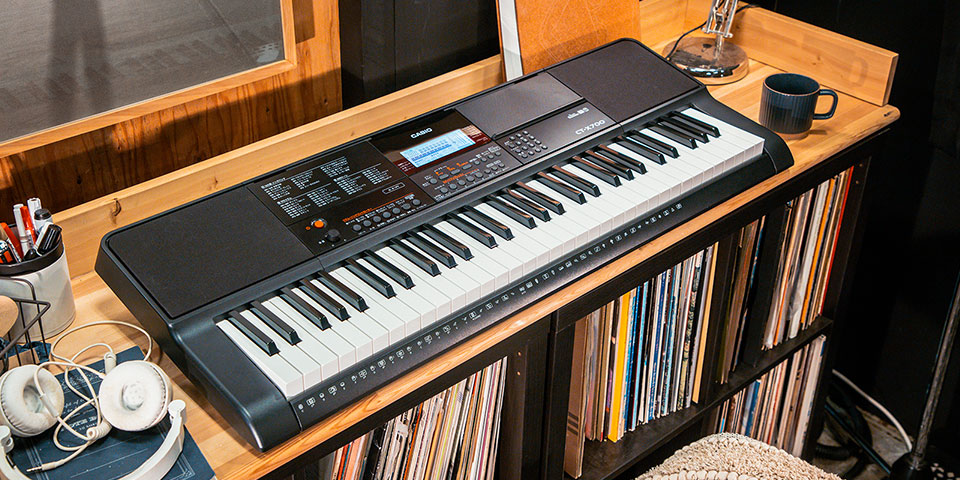
I have to say, the sounds are actually not bad at all for what you would expect for the price. Comparing these to even 10 years ago, you will notice a lightyears difference in quality.
The keys on the CT-X700 very basic and they are what you will find on basically anything near this price range.
You can adjust the touch response, but they’re still going to please you the way non-weighted keys will.
While this is definitely built for beginners, professionals could use this as a portable option for when they are on the go. The stock sounds are not terrible and it weighs in at less than 10 lbs.
Should you be a songwriter, you will also be able to lay out some basic arrangements to get an idea of exactly what you’re looking for in your song.
Here’s a quick look at the massive number of preset sounds:
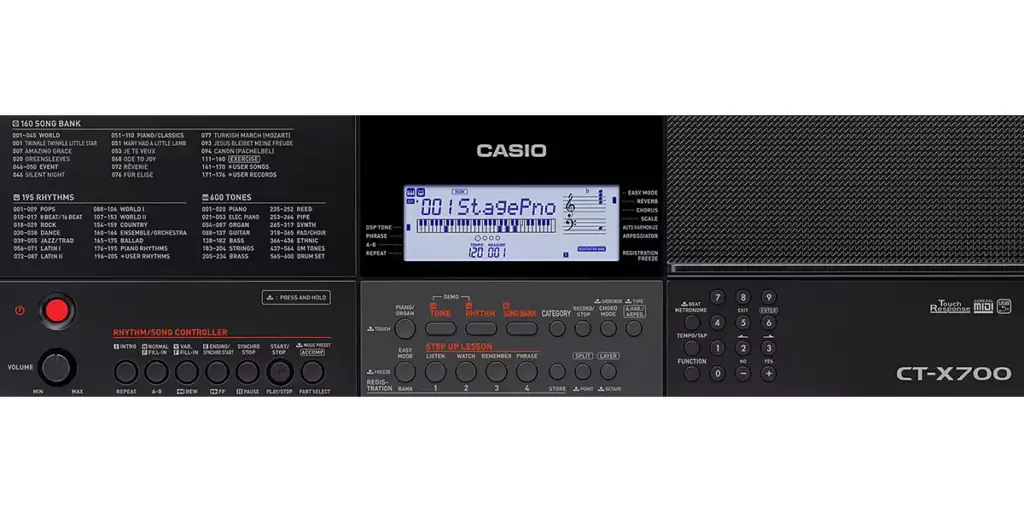
The last couple of things that make this keyboard a decent pick is that it comes with solid speakers and it also comes with some learning software that you can connect to your PC/laptop or iPad.
Overall, I would not recommend this to anyone who’s not a kid or just looking for an extra keyboard to experiment with.
9) Yamaha NP-15 – Best For Those On A Budget And Wanting More Than 61 Keys
The NP-15 is the predecessor to the NP-12, an iconic Yamaha keyboard. The NP-15 has surprisingly nice key-action, even though it's just semi-weighted. If you're in the market for something cheap, yet solid, this is a good pick.
This keyboard is a step-up when it comes to the key-action of the keyboard itself, from the Casio keyboard above.
That being said, the NP-15 is built mainly to emulate an acoustic piano for as cheap as possible. This is where cutting some corners comes into play. The NP-15 has 61 non-weighted keys, although they do feel a lot nicer than some of keyboards near this price, in my opinion.
When playing the NP-15, I expected the keys to feel a bit better than they would, as I’m used to the P-45. The keys aren’t weighted and it’s apparent to those who have played for years like myself.
There are far fewer sounds as the NP-15 only has 10 sounds, however, it provides you with the basic sounds you need to just get started.
The Yamaha NP-15 is great for someone looking to test the waters and get a little bit closer to the feeling of an acoustic piano.
One of the features of the NP-15 is that it can be powered by 6xAA batteries, not needing a power source. This is a neat feature should you be traveling or lacking an area with sufficient power.
Yamaha has done a fantastic job producing some quality keyboards at a budget price. The NP-15 is no exception to this.
Key-Action
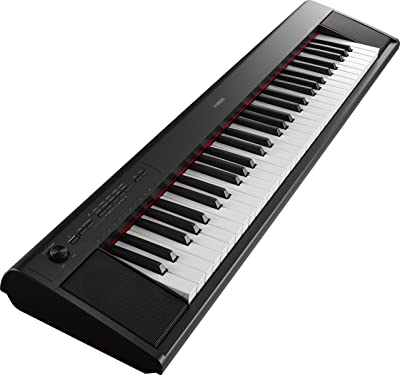
The NP-15 lacks weighted keys as mentioned above, however, for someone just starting to play, it is pretty impressive.
While this isn’t going to compete against anything with weighted keys, you would be saving at minimum over $100.
Features
As far as features go, it’s pretty slim pickings. You’re quite limited with features, outside of having some reverb effects built-in as well as a metronome.
Should you be looking to keep the noise down, there is a headphones jack as well which will allow you to easily plug and play.
The NP-15 features 64 note polyphony, which should be just fine. The only reason this wouldn’t be enough would be if you were trying to layer a bunch of different sounds together.
Our Opinion
If you’re buying this for your kids, it will make a solid digital piano. Should you be purchasing for an adult, they may outgrow it in the upcoming year or two, depending on their abilities.
Best Digital Pianos Under $500
Should you be focusing on options that are under $500, I highly recommend checking out a complete guide to the best digital pianos under $500.
With this being said, let’s take a look at a couple of solid options under this price tag. These are going to get you a digital piano that will last you a couple of years easily before upgrading.
Since this price point is aimed towards beginners, you will notice that these options will come with learning software as well, such as piano apps or subscriptions to services.
8) Alesis Recital Pro – Great For Beginners
Alesis brings to the table 88 weighted keys in perhaps the most budget friendly digital piano that is also quality. I've played this for many hours and I'm blown away by the price tag.
The Alesis Recital Pro is the first entry-level digital piano with weighted keys for under $400. Alesis provides you with an acceptable digital piano targeted towards kids and or first-time players.
Over the years, Alesis has focused on providing solid instruments at a budget price. Even outside of their digital pianos, they also provide some entry-level electronic drum kits as well.
So, what does the Recital Pro offer?
Overview Of The Alesis Recital Pro
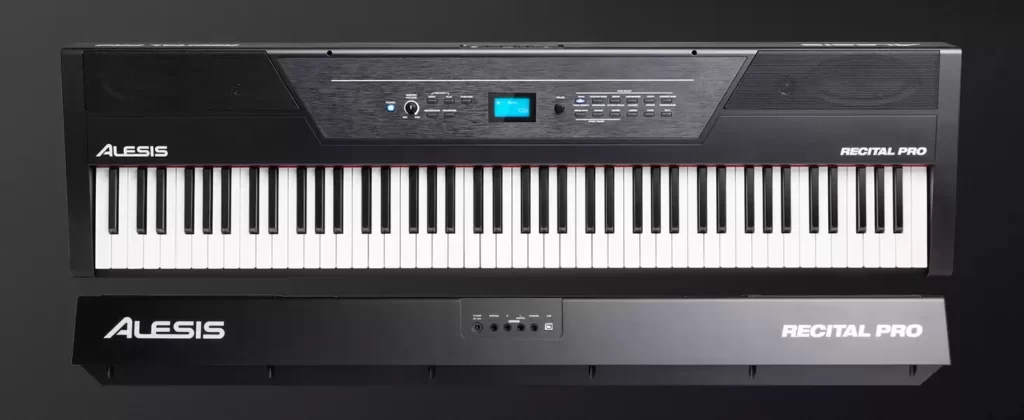
The Recital Pro is a lightweight, entry-level digital piano that is geared towards beginners. It’s not geared towards beginners just because of its price, but also because of what it offers.
With that being said, I was shocked when I got my Recital Pro as I wasn’t expecting weighted keys. The Recital Pro and the Prestige series by Alesis actually play extremely well for their price point, even when compared to my Roland’s.
Features
The Recital Pro is equipped with lessons mode, which is one of the main features. This allows you to split the piano evenly with the same voices.
It is meant to allow instructors and students to practice together at the same time. This is crucial for learning songs and repetoire.
For example, when learning new material, you can play the song with your instructor at the same time. Traditionally, you would have to take turns and let your instructor play it after you play.
What We Like
Weighted keys for this price is a pretty good feat that Alesis has accomplished. It’s not common for digital pianos to have weighted keys for such a low price.
While the action of the keys doesn’t compete with some of the higher-end digital pianos, it is definitely a step up from non-weighted keys.
The polyphony is impressive for this price range. 128 note polyphony is typically seen above the $500 price-point, so this is a win for the Recital Pro.
Alesis provides you with 2×20 watt speakers with the Recital Pro. This is a solid set of speakers and you also have a headphones jack that you can plug into with ease.
What We Don’t Like
This is an entry-level digital piano. The Alesis Recital Pro is solid for beginners, but on the big scale, it doesn’t compare to say the Roland FP-30X which is about $500 more in price.
This being said, the actual sounds on the Recital Pro are the one thing that they could improve upon.
They don’t sound terrible, but you will notice a difference as you go up in price here.
The simple fix is that you can use the Recital Pro as a MIDI controller and use a piano VST. What this means is you will connect your digital piano to your laptop, (this is super common), and then you will use a virtual piano.
Some of these virtual pianos sound incredible and they will greatly improve the sound.
Verdict
If budget is a major concern, this is a great pick. You are getting the bare bones, but the bare bones in an acceptable manner for a great price.
Should you want better sounds and a little more quality in the key-action, go up to the Korg B2 which is listed below this.
7) Korg B2 – Our Choice For Under $500
The Korg B-2 is Korg's option for the $500 price point. It's not loaded with a ton of features, but provides a solid play for beginners.
Take it from Jordan Rudees, Korg makes some killer digital pianos. If you’re not familiar with who he is, he one of the most iconic pianists in rock bands of all time.
When it comes to this price-point, the Korg B2 is often compared with the Yamaha P-45 and the Roland FP-10. The B2 competes well against both the P-45 and FP-10, however, recently, the FP-10 was discontinued.
The Korg B2 features a very minimal, yet effective approach in that it is slim and sleek, lacks an LCD interface, and presents impressive sounds.
The B2 features the Korg sound module app, which allows you to choose between six sounds engines when choosing a preset.
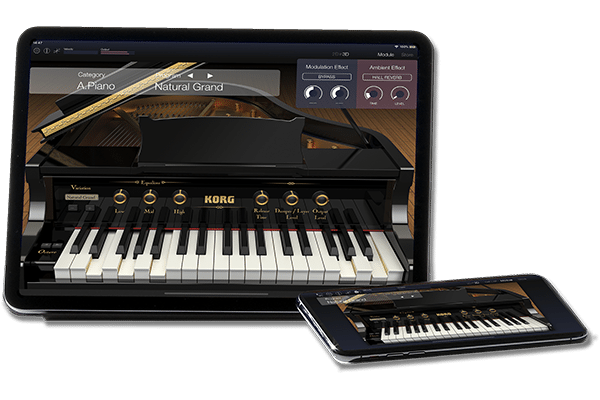
As far as presets go, you will 12 piano presets and one organ. While this is the bare minimum for presets, the pianos sound realistic and warm.
For those of you who like options, the B2 is available in all white and all black.
Keys

Korg has chosen to go with their entry-level key-bed called the Natural weighted hammer-action key-bed. While this isn’t quite on the level as some of Korg’s more prestigious digital pianos, it is still solid.
I recently owned the Korg Krome EX88, which has the same key-bed as the B2 and I have to say, it’s pretty decent. As someone who has played for 20 plus years, I don’t believe beginners would need much more than what this digital piano offers.
The keys themselves feel very synthetic and heavily plastic-based, but they place nicely and similarly to a real piano. I’ve always thought this about Korg in the key department, but I know countless individuals who absolutely love their keys.
3 Month Trial Of Skoove

For those of you interested in online piano lessons, Skoove is a great subscription based course. What this means is that you can connect your keyboard to your PC or smart phone and then begin your lessons.
Now, the lessons are all pre-recorded, so you will just be following course material over a period of time.
The material ranges from beginners to advanced, but it focuses mainly on educating beginners and getting them used to the dynamics.
Read more on Skoove in our full review here.
Presets
The B2 brings to you a total of 13 presets including 12 pianos and one organ. Overall, the sounds are realistic and I personally believe they are a little bit better than the Casio CDP-S150.
That being said, this is subjective, and I always encourage you to do some sound comparisons before purchasing.
Our Verdict
The B2 gives you what you need as a beginner. It’s not going to blow your mind if you’ve been playing on an acoustic piano for years, but it will provide you with what you need to get a great start.
View the price and other owners reviews here at Sweetwater
Best Intermediate Digital Pianos Under $1,000
This is the category that I usually recommend to those who can afford it and to those who have been playing the piano for a couple of years.
Frankly, you can get a whole lot of features and fantastic sounds at this price point. Should you go with one of these options, you will end up with a digital piano that will last you many years.
6) Yamaha P-125 – Best Budget Intermediate Piano
The P-125 is revered in the digital piano community as one of the budget friendly choices that still gives you a great play.
The Yamaha P-125 gives you a nice step-up from anything mentioned thus far. With this being said, we are just above that beginner range of digital pianos.
The main improvement you will notice as you start to get to the range of under $1,000 is going to be in the sound department.
Great For Gigging
The connectivity of the P-125 is impressive as it gives you everything you need to start playing professional gigs. As far as the audio outputs go, they are as followed: 2 x 1/4″ (aux out)
You will have professional quality in the sounds, decent keys, and an extremely portable digital piano. This is everything that you need when it comes to playing shows at this level.
What We Like
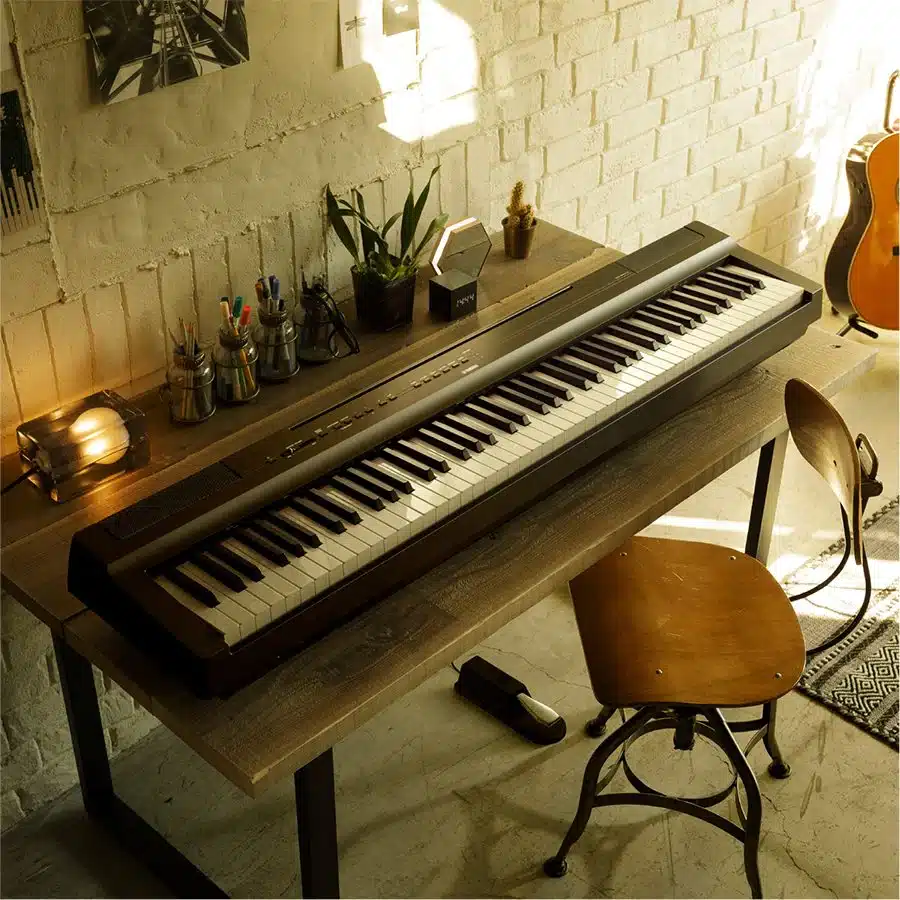
The sampling for the piano sounds is fantastic. If you listen to any reviews of the P-125, you will notice that many find the P-125 to be quite impressive as far as sounds go, I too have this opinion.
Yamaha has done 4-level sampling on the famous Yamaha 9′ Grand piano and it has turned out great. What this means is that they have layered 4 different sounds per note to try and make the sound as realistic as possible.
In order to do this, Yamaha had to increase its polyphony. You will find a massive 192 note polyphony on the P-125.
The speakers on the P-125 are solid and provide the pianist with a full and crispy sound.
The Bad
Overall, the one thing that could be better is the key-action. Now, if you’re a beginner, you probably won’t notice this at all and might even really enjoy it.
For those who have been playing for years, you may be a little bit pickier. Now, this is always a preference and some may hate it and some may love it.
This being said, I personally believe the keys could feel and play better and more realistically.
The P-125 also drops the ball when it comes to Bluetooth abilities. We are seeing a trend with the more modern digital pianos really pursuing Bluetooth. I love it, and really wish the P-125 had it.
Verdict
The P-125 gets you to that intermediate range of digital pianos, providing you with a realistic experience worthy of trying out.
5) Roland FP-30X – Our Top Pick Under $1,000
The FP-30X is the new improved version of one of my favorite mid-level digital pianos, the FP-30. Built with a solid key-bed and impressive piano sounds, the FP-30X provides pianists with everything they need for an affordable price.
The FP-30X is your next destination as you go up slightly from the P-125. I believe the key-action and Bluetooth abilities put the FP-30X a step-up.
Roland has continued to push the envelope on their portable digital pianos and this is one of their newest creations.
This series used to be called the FP and it just recently turned into the FP-X.
You will see that we feature the FP-90X later in this article and this is just their highest end option.
This keyboard is often compared with the Casio PX-870, which we will talk about next. I, personally like this option more than the PX-870.
The only area that the Casio wins would be in the speaker department, which you can always wear headphones.
Keys

I have always been partial to Roland’s key-action. This digital piano features the PH-A4 key-bed, which is solid.
The keys themselves play like an acoustic piano and they have just the right amount of weight to them for my liking.
Another place that they excel is that they have a synthetic ivory feel that is extremely close to an acoustic piano. This differs from some of the cheaper options as you feel heavily plastic keys.
Features
The FP-30X boasts some impressive features including Bluetooth capabilities, great connectivity, beautiful presets, and a solid sound system.
The Good
Weighing in at roughly 35 lbs, this digital piano provides you with a heavyweight experience at a reasonably low weight.
It’s slim and sleek and very easy to navigate around on. The Bluetooth capabilities feature both audio and MIDI, which gives you some great options.
256 note polyphony for this price range is pretty unheard of. With this being said, I would expect to see it more often now that Roland is pushing the envelope.
Included when purchasing is the Roland DP-10 sustain pedal, which is a $55 pedal typically. This is personally one of my favorite pedals to use.
Where It Could Improve
For this price point, it’s hard to say where Roland could improve. You are getting a lot of value for what you’re paying overall.
This being said, if there’s anywhere the FP-30X could make some slight improvements, maybe in the sample and speaker department.
Verdict
To see our full thoughts, check out the review here. Overall, I believe the FP-30X is the best pick under $1,000.
While the speakers of the PX-870 outshine it, the sounds and key-action of the FP-30X take a higher ground.
4) Casio Privia PX-870 – Best Console Style Piano Under $1,000
The PX-870 is one of Casio's flagships, especially for the price tag. This keyboard truly surprised me with it sounds quality through and through.
When it comes to the console type of digital pianos, the PX-870 offers you some solid ground. You typically think of Casio as a more entry-level type of keyboard company, but I have to say, the PX-870 shines in the intermediate price range.
Overview Of The PX-870
Design-wise, the PX-870 is sleek and simple. It looks clean and it comes with the 3 pedals as well. Overall, the PX-870 is pretty solid in most departments and it offers you alternatives to the powerhouse brands such as Kawai, Roland, and Yamaha.
If you’re someone who really wants to have the 3 pedals and you don’t want to purchase an extra stand, you will be happy with the PX-870.
Casio has been marketing the P-X-870 as their flagship digital piano and I think they make a good point.
Presets
The PX-870 is equipped with 19 preset sounds that have been produced by AIR, which is Casio’s Acoustic and Intelligent Resonator. This allows the PX-870 to access more than 3 times the memory than previous models.
What We Like
The PX-870 features some incredible speakers that can fill the room quite easily, featuring a 40-watt, four-speaker Sound Projection system.
Casio has done a great job improving on their previous sound with their digital pianos with the PX-870. It had been years since I had played on a Casio keyboard, outside of toying around on kid’s pianos.
Immediately upon playing the PX-870, I could see what people were talking about when they said Casio had improved.
An advantage with these console type digital pianos is that they take advantage of their speakers as the sound radiates throughout the PX-870.
This is similar to what happens when playing on an acoustic piano.
If you’re someone like me who enjoys tweaking the sound of their pianos, you will love the onboard effects system. It features 4 x Reverb, 4 x Chorus, 3 x Brilliance effects.
Lastly, the PX-870 boasts a whooping 256 note polyphony which should be capable of playing even the most powerful piano VSTs.
The Bad
I am not a huge fan of how the keys feel personally. The keys are a bit noisy upon playing them, however, when the speakers are turned up, you don’t really notice this.
This will come down to preference. To some, this may not be a big deal, and for others who are playing a little bit quietly, it might be more of an issue.
As I’m someone who typically enjoys portable options, the PX-870 is a bit heavy for my taste.
Verdict
I believe the PX-870 is a fantastic digital piano under $1,000. If you’re looking for something near this price point for your home, this could be your pick.
Best High-End Digital Pianos From $2,000 & Up
We are now on to the part of the article in which we introduce the heavy-hitters. While these are options are expensive, all of these options are investments that you will get many years out of.
3) Roland FP-90X
The FP-90X is one of the top picks currently on the market. With some of the most realistic key-action on the market, the FP-90X is an easy choice.
When factoring in value, price, key-action, sounds, and features, I have come to the conclusion that the FP-90X is the best option overall This is completely subjective, but I really can’t get enough of the FP-X series.
The FP-X90 has improved in the sound department from the FP90 making it a contender for one of the most impressive digital pianos currently available.
If you are someone who has the money and likes the idea of incredible key-action as well as portability, then this is a fantastic choice.
This is the best version that the FP-X series has to offer, but it also the most expensive.
Key-Action
The key-action is one of the major selling points to the FP-90X in my opinion. It features the PHA-50 key-bed, which is Roland’s staple key-bed.
This is designed to truly emulate the intricacies of an acoustic piano in every way. This key-bed is a little heavier than your traditional digital piano, as it features hybrid wood and plastic construction.
To me, this is about as close as a digital piano has gotten to emulating the key-action of an acoustic piano.
Polyphony
The FP-90X features unlimited polyphony for pianos and 256 note polyphony for other presets. This is quite impressive and it will definitely be something you will be able to take advantage of.
The FP-90X uses 4 samples per every note, so as you start to add up the polyphony, it goes up quite drastically.
The Good
There is really a lot that we like when it comes to the FP-90X. It features incredible polyphony, great key-action, a solid speaker system, beautiful sounds, and amazing Bluetooth connectivity.
All of those are featured in a digital piano that weighs under 56 lbs. Should be looking to tour, the FP-90X would make a great option.
For those looking to taking piano lessons, you can hook up two headphones at the same time, should be wanting to link up with your instructor, or simply keep the noise down.
Should you really enjoy having 3 pedals, you can opt to purchase the stand that has a 3 pedal unit. I, personally don’t miss not having 3 pedals when I play digital pianos, but I can see why some do.
The Bluetooth capabilities are simply awesome with this digital piano. Having Bluetooth MIDI is a game-changer for when you are recording.
As far as the sounds go, I think the pianos sound better than FP-90 and they compete with everything near this price-point.
The speakers feature 8 x 4.7″, 2 x 1″ which is quite impressive from a digital piano.
You will also find amplifiers that are 2 x 25W, 2 x 5W.
Overall
Overall, this is my favorite digital piano currently available. With a solid speaker system, fantastic key-action, and great polyphony, it’s hard to compete with the FP-90X as a stage piano.
On the downside, this is an expensive digital piano.
2) Kawai CA59
The Kawai CA59 is one of my favorite digital pianos I have played to date. The overall piano sound is phenomenal and the key-action is out of this world.
Nearing the end of our list, we feature the Kawai CA59 console style digital piano.
The build of this is extremely impressive and the CA59 is a very powerful digital piano.
From a young age, I have always enjoyed Kawai digital pianos. The CA59 is one of the top options that Kawai makes and this is of no surprise.
Personally, this is my favorite console style digital piano at the moment.
Key-Action
The key-action on the CA59 is right there with the best of them. It really feels extremely similar to an acoustic piano.
You will find that people who like Kawai digital pianos typically swear by them and don’t enjoy other brands as well.
The CA59 features Grand Feel compact wooden keys. The tops of the keys are synthetic ivory to really give you a true acoustic piano feel.
The grade-weighted hammers and bass region counterweights give the pianist very realistic playability with their digital piano.
The Bad
While the Kawai CA59 has some impressive features, it doesn’t come with a lightweight. The CA59 weighs 151 lbs, which is a massive amount for a digital piano.
The CA59 also lacks Bluetooth MIDI, which might not be a big deal for most, but for me, I prefer to have the capability.
Outside of these two things, there’s really not much more that I don’t think is great with this digital piano.
Overall
As far as console-style digital pianos go, this is the one that I would purchase should I be buying.
It has impressive speakers, top-of-the-line key-action, beautiful piano sounds, and great polyphony.
As said above, the only thing I’m not a huge fan of is the weight as you wouldn’t really be able to gig with this.
That being said, this isn’t built for gigging, it is built for homes.
1) Yamaha Clavinova CLP-775 – Best Professional Option

The Yamaha Clavinova CLP-775 is Yamaha’s high-end option that they have to offer.
There really aren’t any areas that I don’t fantastic with the CLP-775, outside of its price tag.
Everything that you will see with this digital piano is going to be the highest-end that Yamaha can offer.
VRM Physical Modeling
Virtual Resonance Modeling is used to re-create the acoustic phenomenon that we see in a grand piano in which sound resonates throughout the entire body of the piano.
What VRM does is calculates the various states of the strings from one instant to the next for all of the 88 keys.
Personally, I believe this leads to providing us with an incredibly realistic sound overall.
The Good
The GrandTouch keyboard with wooden keys also has synthetic ivory and ebony keytops. At this price-point, this is almost assumed as we want to have the closest possible feeling to a real acoustic piano.
The speaker system is very powerful featuring 2 x 6.29″ speakers and a massive
2 x 42W + 50W + 50W amplifiers.
These are the most powerful amplifiers I have seen in a digital piano by far. This sound echoes through the body of this digital piano, leaving us with a fantastic sound.
The CLP-775 also has 256 note polyphony, 256 note polyphony, 38 voices, includes a bench as well as has an LCD screen.
Overall
For this price, the only thing that Yamaha could have possibly included would’ve been Bluetooth MIDI. As far as I know, this lacks Bluetooth MIDI.
Everything else with the CLP-775 is top-notch and personally one of my favorite options overall.

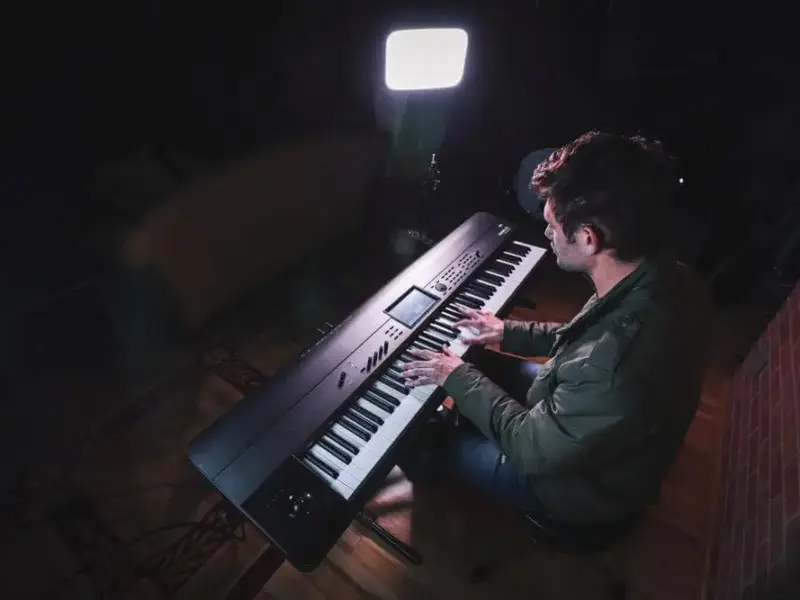
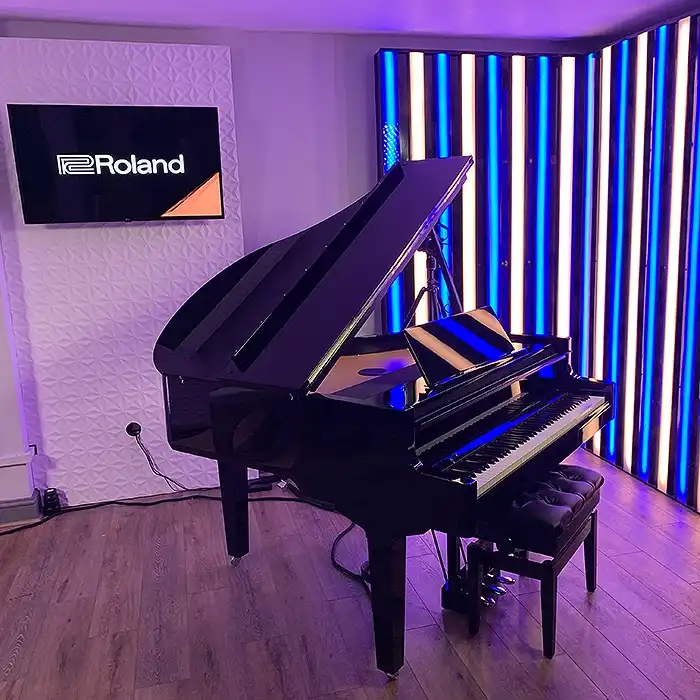
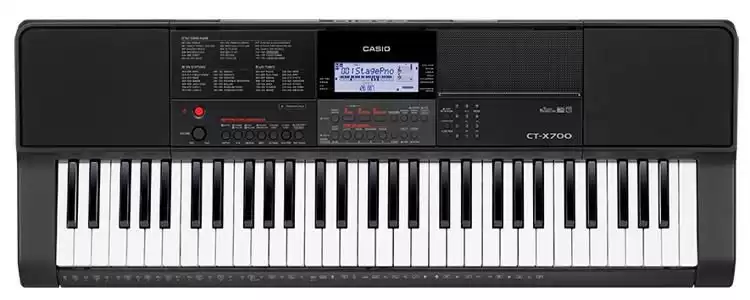
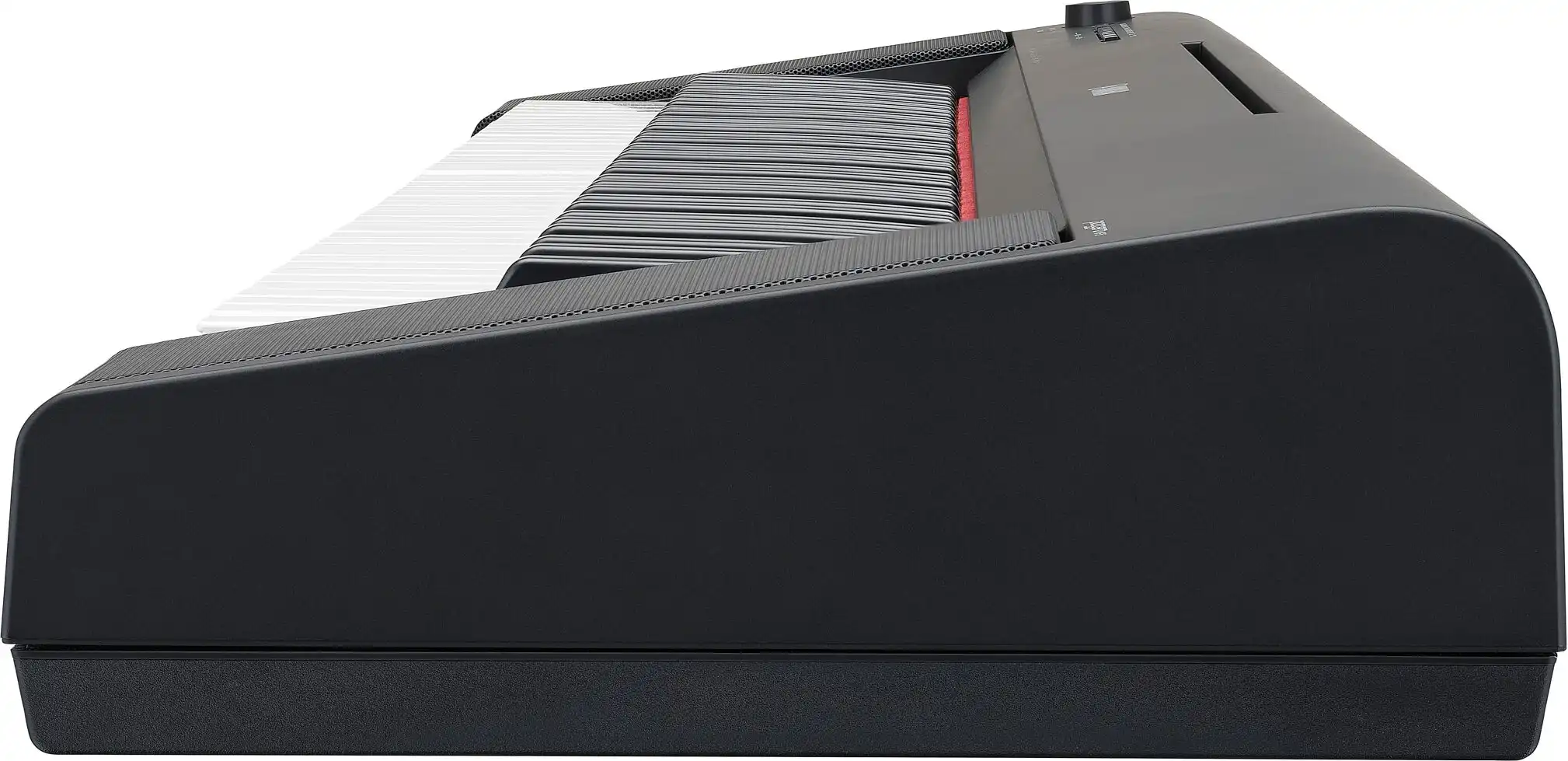
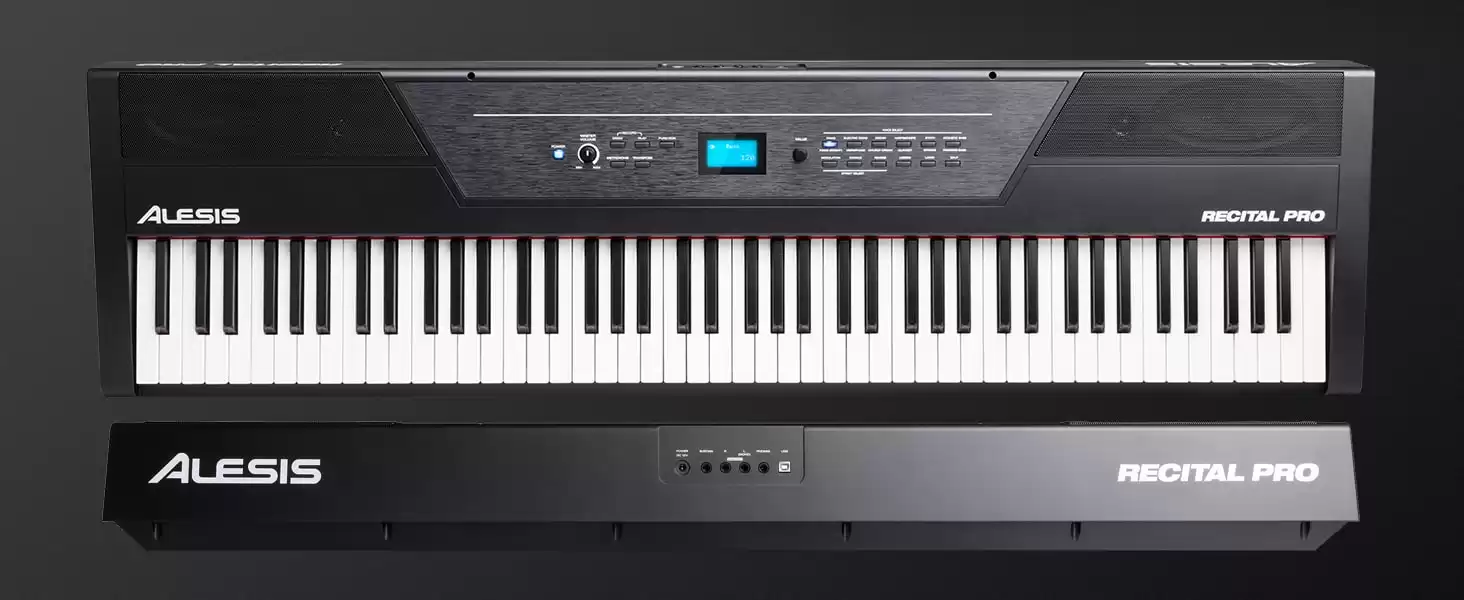

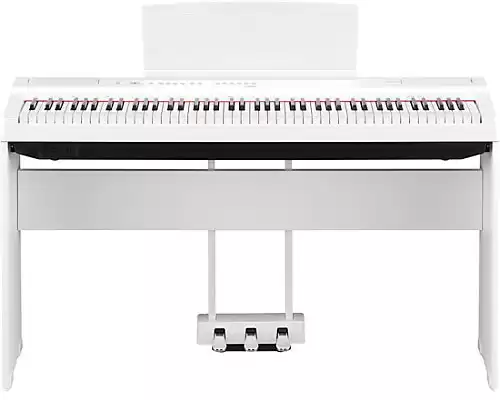
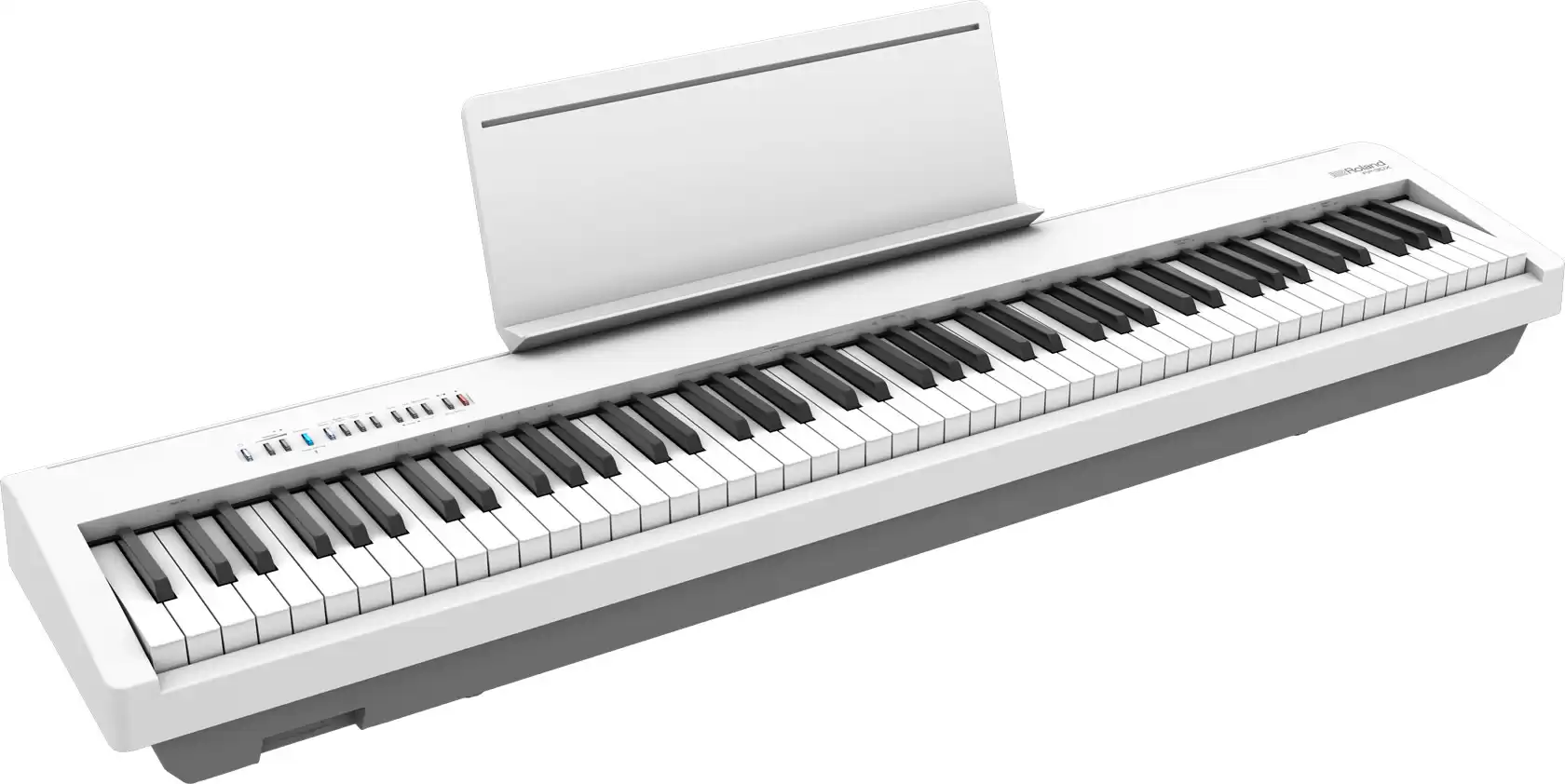

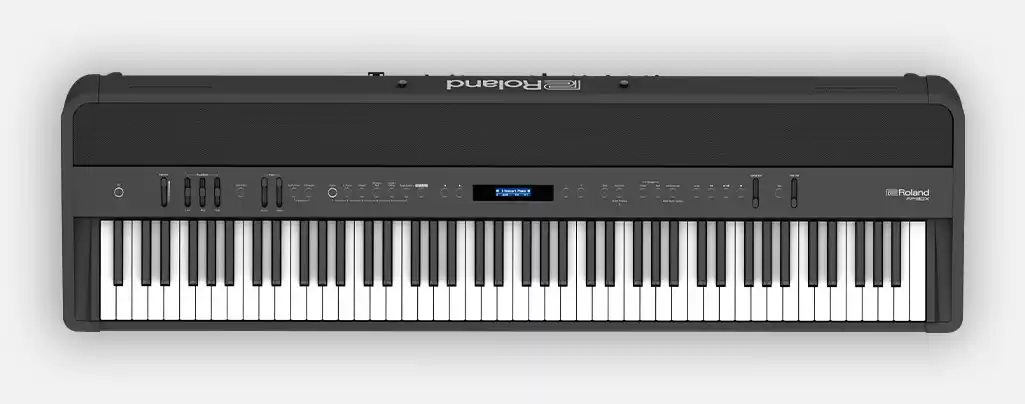

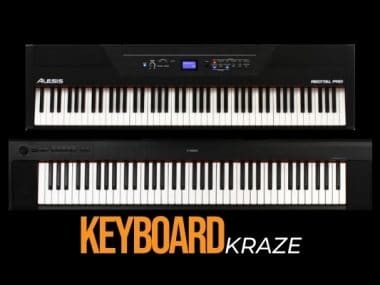


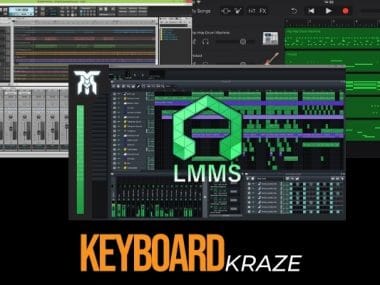

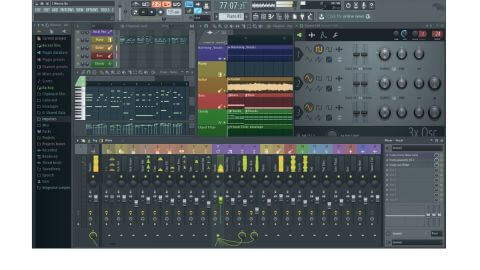
15 comments
Great reviews as always Chris, keep up the good work and i’ll buy via the links
Hi Henrik,
Thanks for the note. Which digital piano is your favorite currently?
Chris
Hi Chris. Thank you for putting in the hours of research into this review. It is great to have a review done by an actual pianist who has accomplished so much in music. Keep up the good work, and I look forward to reading the new digital piano articles!
Phil, thanks for the comment. It’s my pleasure as I love talking about all things keyboards!
Hey Chris, just found out about this site. Really a great article.
2 Comments regarding this article:
– Would be great to include App-Capabilities/Limitations in such an overview
– I’m really confused about sampling and modelling the sounds. For Roland you write “The FP-90X uses 4 samples per every note”. But my understanding is that Roland is using modeling and not sampling. But Yamaha seems to be using sampling, yet also having “Virtual Resonance Modeling”. This seems to be quite confusing.
All in all, I really appreciate your work and love this article.
I will continue digging deeper on your page!
Best regards
Sebastian
Thanks for the note! I totally agree and I will add a section that breaks down piano apps that come with digital pianos!
Chris
Great job including the Kawai CA59 in this list. I personally own it and I’m blown away by the action and sound. Look forward to reading more from you! My one question is, do you think the FP-90x is better than the Yamaha P515?
Thanks,
Rudy P
I’m a singer-songwriter looking for a small (as in non 88 key) portable piano keyboard with decent speakers and a mic input. I am definitely NOT looking for anything with more than 76 keys, and I’d really like something smaller.
I have a roland 90x at home, for myself. This would be just a handy second keyboard, and I would like my small piano to have good piano sounds, but I am not expecting miracles. I would prefer it not feel like a toy, but really I just want it rugged enough to be put in a backpack. 700 is about the most I am willing to pay. The Roland Go keys is about the right form factor, but the speakers are too weak and there is no mic input.
I am basically looking for something to take to songwriter circles, or to play a song or two in a cafe or very small club setting. Recording, other voices, loops, etc. are all fun features, but not something that would affect my decision in any way. Any suggestions?
Yamaha P-125
3
Hi Chris,
Thank you so much for this guide. I have been looking for options for my grandchildren for months. Would you recommend the Alesis Recital Pro or the Prestige?
Thank you,
Annie
Hi Annie,
Thanks for the question. The Recital will do just fine, but I would personally recommend going for the Prestige.
Thanks for the reviews.
I did a lot of research and demoing many digital pianos before making my choice. I was an owner of a baby grand piano which was getting to the point of needing some major repairs. The cost of the repairs were going to be quite high. After considerable thought I felt that maybe a digital piano was the way to go. The Yamaha CLP 775 was by far, hands down, the best. The sound, keyboard action and pedaling performance were so amazingly close to my real acoustic piano that it was almost indistinguishable. In the long run, I highly recommend the Yamaha CLP 775 for anyone who is seriously interested in getting a high quality digital piano. One last thing, the CLP 775 does come with Bluetooth midi and Bluetooth audio.
Thanks for the review! I am wondering what you think of the Roland RD-88. It’s on sale now for 999. Seems better than the 30x for specs.
Hi Heath,
I own the RD-88 and play it regularly. It’s a fantastic choice with more presets as well!
Kind regards,
Chris